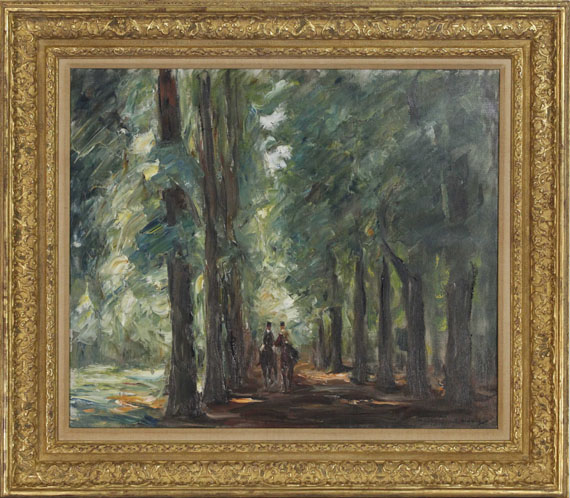874
Max Liebermann
Zwei Reiter in der Allee bei Sakrow, Wohl 1924.
Oil on canvas
Estimation:
€ 150,000 / $ 177,000 Résultat:
€ 300,000 / $ 354,000 ( frais d'adjudication compris)
Zwei Reiter in der Allee bei Sakrow. Wohl 1924.
Oil on canvas.
Cf. Eberle 1924/ 41. Signed in lower right. 63.5 x 75 cm (25 x 29.5 in).
With the stamp of Leopold Hess Berlin, art supplies, on the stretcher.
With an expertise from Prof. Matthias Eberle, Berlin, issued on October 16, 2018.
PROVENANCE: Fred Sanford (born Fritz Saalfeld), presumably acquired in Berlin before 1936.
Elisabeth Sanford, (born Kaufman, married Fleischer), inherited from aforementioned.
Eve Peterfreund (1928-2017), inherited from aforementioned.
"This is the poetry of true painting: with its own mans of expression, drawing and color, enchanting us with a feeling of light and air." Quoet from: Max Liebermann, Die Phantasie in der Malerei. Reden und Schriften, published by Günter Busch, Frankfurt am Main 1987, p. 91.
Oil on canvas.
Cf. Eberle 1924/ 41. Signed in lower right. 63.5 x 75 cm (25 x 29.5 in).
With the stamp of Leopold Hess Berlin, art supplies, on the stretcher.
With an expertise from Prof. Matthias Eberle, Berlin, issued on October 16, 2018.
PROVENANCE: Fred Sanford (born Fritz Saalfeld), presumably acquired in Berlin before 1936.
Elisabeth Sanford, (born Kaufman, married Fleischer), inherited from aforementioned.
Eve Peterfreund (1928-2017), inherited from aforementioned.
"This is the poetry of true painting: with its own mans of expression, drawing and color, enchanting us with a feeling of light and air." Quoet from: Max Liebermann, Die Phantasie in der Malerei. Reden und Schriften, published by Günter Busch, Frankfurt am Main 1987, p. 91.
874
Max Liebermann
Zwei Reiter in der Allee bei Sakrow, Wohl 1924.
Oil on canvas
Estimation:
€ 150,000 / $ 177,000 Résultat:
€ 300,000 / $ 354,000 ( frais d'adjudication compris)




 Lot 874
Lot 874 
